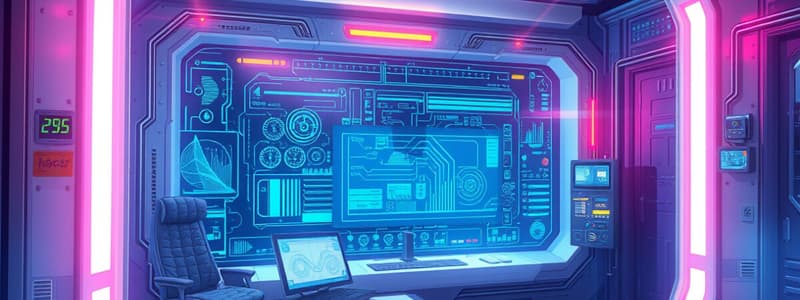Podcast
Questions and Answers
Which of the following are examples of control systems? (Select all that apply)
Which of the following are examples of control systems? (Select all that apply)
- Bicycles
- DVD players (correct)
- Elevators (correct)
- Radar system (correct)
What is the primary purpose of a control system?
What is the primary purpose of a control system?
To obtain a desired output with desired performance given a specified input.
The pancreas is an example of a control system in the human body.
The pancreas is an example of a control system in the human body.
True (A)
During 'flight or fight', adrenaline increases along with our ______.
During 'flight or fight', adrenaline increases along with our ______.
What are the four primary reasons for building control systems?
What are the four primary reasons for building control systems?
Who invented the water clock that used a float regulator?
Who invented the water clock that used a float regulator?
What was the first automatic feedback controller used in an industrial process?
What was the first automatic feedback controller used in an industrial process?
Open-loop systems do not measure the output variable.
Open-loop systems do not measure the output variable.
What is one main characteristic of a closed-loop system?
What is one main characteristic of a closed-loop system?
What are advantages of closed-loop systems?
What are advantages of closed-loop systems?
Flashcards are hidden until you start studying
Study Notes
Control Systems Overview
- Control systems integrate components to manage parameters like velocity, torque, and pressure for desired outputs.
- Composed of subsystems and processes designed to achieve specific outputs based on given inputs.
Examples of Control Systems
- Radar systems and satellite systems for navigation and tracking.
- Moon exploration rovers and mobile robots for autonomous tasks.
- Everyday devices such as elevators, regulated power supplies, and traditional media players (DVDs, CDs, VHS).
- Common technology like smartphones controls various functions, albeit with limited intelligence.
Biological Control Systems
- Human pancreas regulates blood sugar levels.
- Adrenaline release during stress increases heart rate for oxygen delivery.
- The body tracks moving objects visually, and hands adjust positioning with precision.
Types of Responses in Control Systems
- Transient Response: Pertains to temporary changes (e.g., elevator speed affecting passenger comfort).
- Steady-State Response: Ensures systems perform reliably without compromising safety or convenience.
Reasons for Building Control Systems
- Power amplification for enhanced capability.
- Remote control for ease of operation.
- Convenience in input handling.
- Compensation for unexpected disturbances or changes.
Historical Development of Control Systems
- Early feedback systems originated with the Greeks around 300 BC, such as Ktesibios' water clock.
- Cornelis Drebbel invented the first modern feedback temperature regulator in the early 17th century.
- James Watt's Flyball Governor (1769) marked the first automatic feedback controller in industry.
- I. Polzunov's water-level float regulator (1765) is another foundational feedback system.
Wartime Advances and Control Engineering
- World War II spurred development in automated systems like airplane pilots and gun control systems.
- The field expanded post-war with increased mathematical methods, establishing control engineering as a distinct discipline.
- The growth of frequency domain techniques utilized Laplace Transform for system analysis.
Modern Control System Applications
- Digital computers now play a crucial role in control systems, utilized in robotics, spacecraft, and industrial automation.
- Frequent use in guidance systems for missiles, airplanes, and ships.
Types of Control Systems
-
Open-Loop System:
- Does not measure output; relies on predefined input commands (e.g., toasters).
- Requires human intervention for proper operation.
-
Closed-Loop System:
- Measures output and uses feedback to align with reference input.
- Effectively corrects disturbances and enhances both accuracy and stability.
Advantages of Closed-Loop Systems
- Greater accuracy in maintaining desired conditions.
- Reduced sensitivity to external noise and environmental changes.
- Enhanced performance in transient response and minimized steady-state errors.
Studying That Suits You
Use AI to generate personalized quizzes and flashcards to suit your learning preferences.




